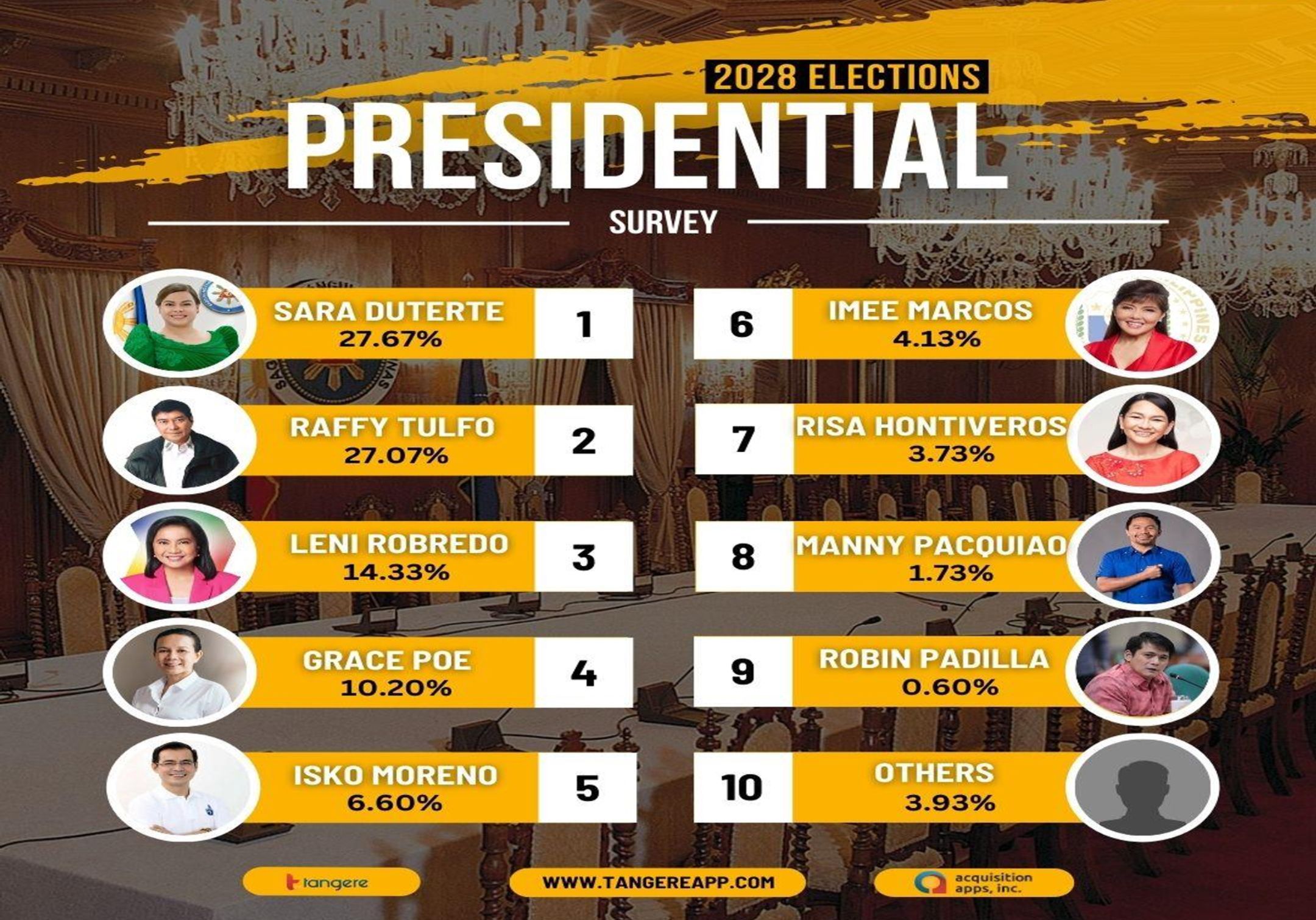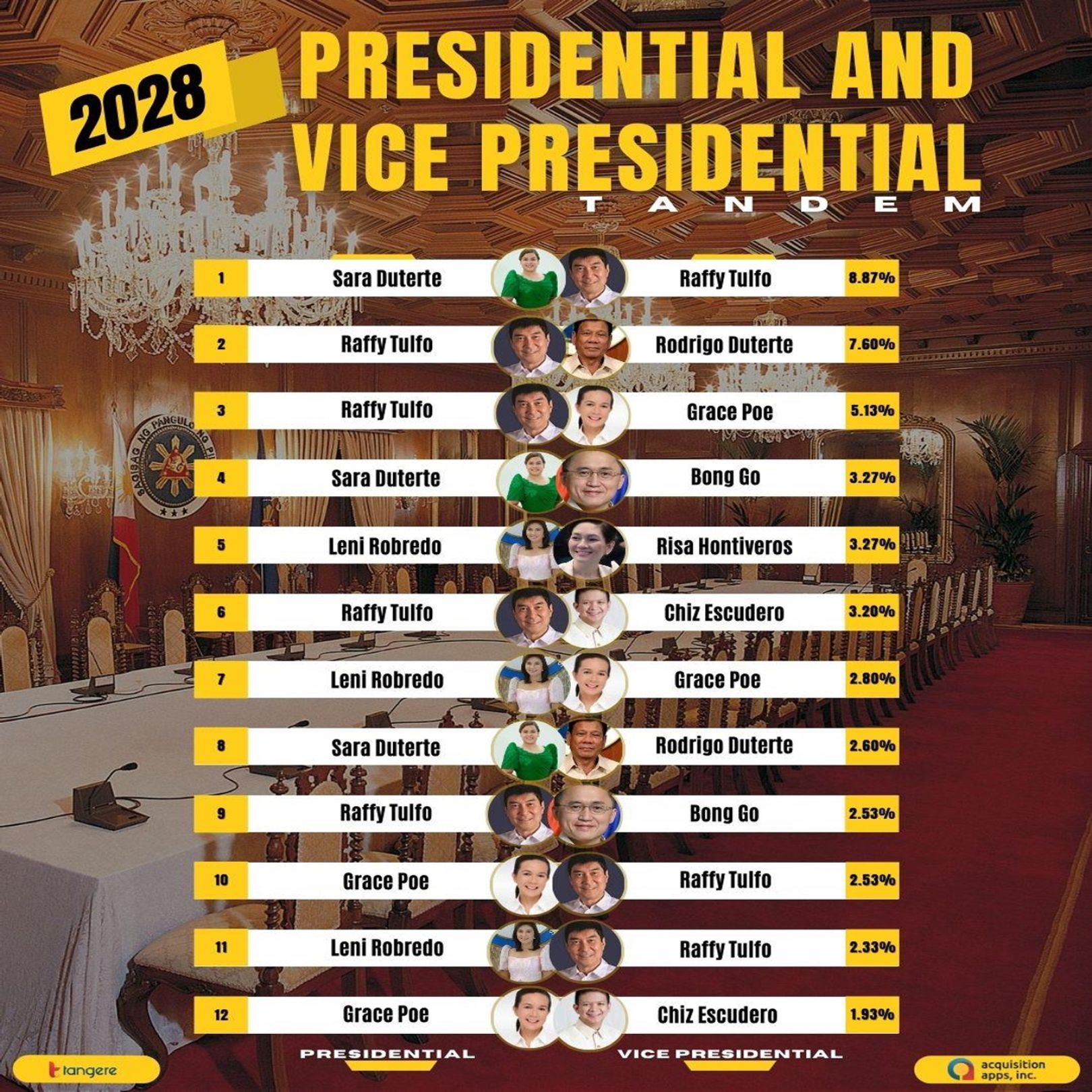Sara, Raffy neck and neck as potential presidential candidates for 2028 elections, Tangere survey shows
At A Glance
- Vice President Duterte and Senator Tulfo received voter preferences of 27.67 percent and 27.07 percent, respectively, indicating a statistical tie considering the +/-2.5 percent margin of error.
- Tulfo also emerged as the leading vice presidential candidate with 17.8 percent of the vote.
- Looking ahead to potential tandems for the 2028 elections, Vice President Duterte and Senator Tulfo emerged as the preferred presidential and vice-presidential pairing.

Vice President Sara Duterte and Senator Raffy Tulfo have emerged as frontrunners in the 2028 presidential poll conducted by Tangere from May 23 to 26.
Based on the survey results made public on Thursday, June 20, Duterte and Tulfo received voter preferences of 27.67 percent and 27.07 percent, respectively, indicating a statistical tie considering the +/-2.5 percent margin of error.
Tangere said the vice president leveraged support from Visayas and Mindanao, while the senator garnered backing from Southern Luzon and Bicol Region.
It also noted that voter preference for Duterte is highest among respondents 18 to 25 years old and between 36 and 50 years old, while Tulfo’s voter preference is highest among respondents 51 years old and above.
Meanwhile, Tangere said that voter preference in Northern Luzon, Central Luzon, and the National Capital Region (NCR) is split between Tulfo and Duterte.
Former Vice President Leni Robredo trailed in third place with a 14.33 percent voter preference, largely driven by support from the Bicol Region and the upper-income class.
Other personalities in the presidential poll were Senator Grace Poe (10.2 percent), former Manila Mayor Francisco “Isko Moreno” Domagoso (6.6 percent), Senator Imee Marcos (4.13 percent), Senator Risa Hontiveros (3.73 percent), former Senator Manny Pacquiao (1.73 percent), and Senator Robin Padilla (0.6 percent).
About 3.93 percent of respondents named others not on the list.

Tulfo leads VP race
During the same survey period, Tangere also conducted a vice presidential poll where Tulfo emerged as the leading candidate with 17.8 percent of the vote.
He was followed closely by Poe with 13.93 percent voter preference, while former president Rodrigo Duterte came in third place with 11.8 percent voter preference and Senate President Francis Escudero at fourth place with 11.27 percent voter preference.
Tangere noted that voter preference for Tulfo is highest in Northern Luzon, Central Luzon, Visayas, and even inMindanao, edging out former President Duterte in his home region.
Meanwhile, voter preference for Poe is highest in Southern Luzon and the Bicol Region.
Other personalities that have been named potential vice presidential candidates were Senator Bong Go (9.6 percent), Hontiveros (7.8 percent), Senator Marcos (5.67 percent), Pacquiao (4 percent), Padilla (3.13 percent), Interior and Local Government Secretary Benjamin Abalos (2.33 percent), former Senator Francis Pangilinan (2.27 percent), Defense Secretary Gilbert Teodoro (2.13 percent), Senator Juan Miguel Zubiri (2.13 percent), Cebu Gov. Gwendolyn Garcia (1.4 percent), and Davao City Mayor Sebastian Duterte (0.87 percent).
About 3.87 percent of respondents named other potential vice presidential candidates not on the list.

Sara-Raffy tandem tops survey
Looking ahead to potential tandems for the 2028 elections, Vice President Duterte and Senator Tulfo emerged as the preferred presidential and vice-presidential tandem.
Other pairings were Tulfo-former president Duterte (7.6 percent), Tulfo-Poe (5.13 percent), Vice President Duterte-Go (3.27 percent), Robredo-Hontiveros (3.27 percent), Tulfo-Escudero (3.2 percent), Robredo-Poe (2.8 percent), Vice President Duterte-former president Duterte (2.6 percent), Tulfo-Go (2.53 percent), Poe-Tulfo (2.53 percent), Robredo-Tulfo (2.33 percent), Poe-Escudero (1.93 percent).
The survey was administered using a mobile-based respondent application with a sample size of 1,500 participants, employing a stratified random sampling or quota-based sampling method.
The respondents were proportionately distributed across the Philippines: 12 percent from NCR, 23 percent from Northern Luzon, 22 percent from Southern Luzon, 20 percent from Visayas, and 23 percent from Mindanao.